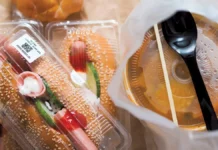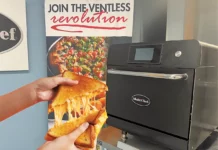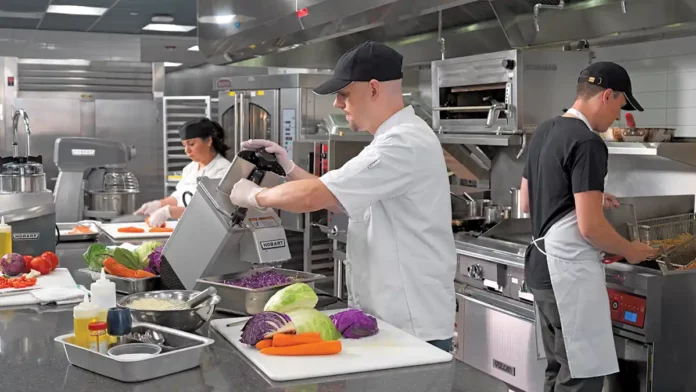
Article contributed by Megan Gray, product line manager, Hobart
As restaurants continue to be challenged by labor shortages, finding ways to gain efficiency in the kitchen is increasingly important.
Having the right equipment can help. A continuous-feed food processor can be invaluable for minimizing prep time — in most cases, reducing it by half compared to manually cutting fruits and vegetables or grating cheeses.
These machines offer the versatility to slice, dice, shred, crimp and more.
To get consistency and quality, however, it is necessary that employees know how to operate the food processor correctly and avoid common mistakes.
Loading incorrectly
The way the operator loads a commercial food processor is the most important part of the process. Loading the machine incorrectly can reduce productivity and can result in inferior quality and inconsistent cuts.
When loading the food processor, follow the inner wall of the hopper. Stack ingredients vertically against the inner wall, moving counterclockwise until the hopper is full.
Cut the tips and tails off produce and fill the hopper completely to create consistent cuts. Leaving excess room in the hopper can cause products to move around, tip on their side or tilt, which can create an inconsistent cut.
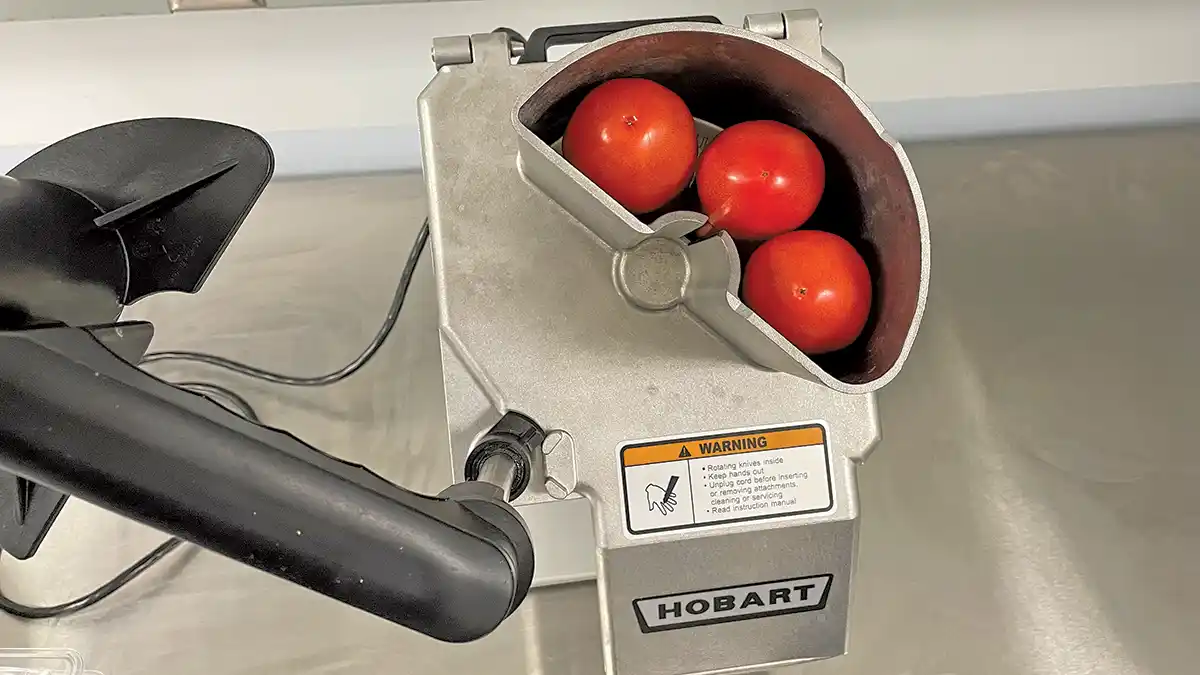
Using the wrong size machine
Having a continuous-feed food processor that meets the volume of product a kitchen needs prepped is key. If a kitchen has a commercial food processor, but finds that staff repeatedly need to load batches, a larger model may be the better choice.
There are several continuous-feed models (countertop and floor) available in the marketplace, all with varying capacity. Some provide throughput as small as 11 pounds a minute with options ranging up to 132 pounds a minute, and several capacities in between.
There are also options for food processors with a half hopper or a full-size hopper. A food processor with a half hopper requires more prep and can hold less product at a time.
A full hopper can hold larger products, like whole heads of lettuce or cabbage, and can handle more volume.
Skipping out on prep
The way chefs and their staff prep products determines the outcome. While it may be tempting to try to let the food processor do all the work, poorly prepared fruits and vegetables can result in poorly processed items.
Some tips to consider are cutting just the tops off peppers and adding them to the hopper whole. This creates pepper rings. Cutting the peppers into panels makes strips of peppers that are perfect for fajita veggies.
Kitchens should experiment with different prep methods to find what works best for the menu items.
How a product is prepped also affects how much can fit into the hopper at once. Whole peppers take up more space than peppers cut in panels.
To maximize space and efficiency, it may be worth taking a little bit of extra time prepping products.
Choosing the wrong cutting tool
If processing ingredients yields a too large or too small of cuts or an undesired style for a given recipe, it is time to choose a different cutting tool.
There are several types and sizes of cutting tools available. A slicer is good for both firm and soft products, such as onions, root vegetables, tomatoes and mushrooms, and can also be used to shred cabbage and lettuce.
Combined with a properly sized dicing grid, it can also dice. For example, if the desired cut of potato is a 3/8-inch cube, use a 3/8-inch dicing grid and a 3/8-inch slicing tool.
Tools are also available for crimping to make rippled cucumbers and carrots and for julienne cutting, which are perfect for processing potatoes for French fries. Grating tools grate carrots and cabbage but are also useful for hard cheeses.
Refer to a cutting tool chart to decide what tool is best for the recipe at hand.
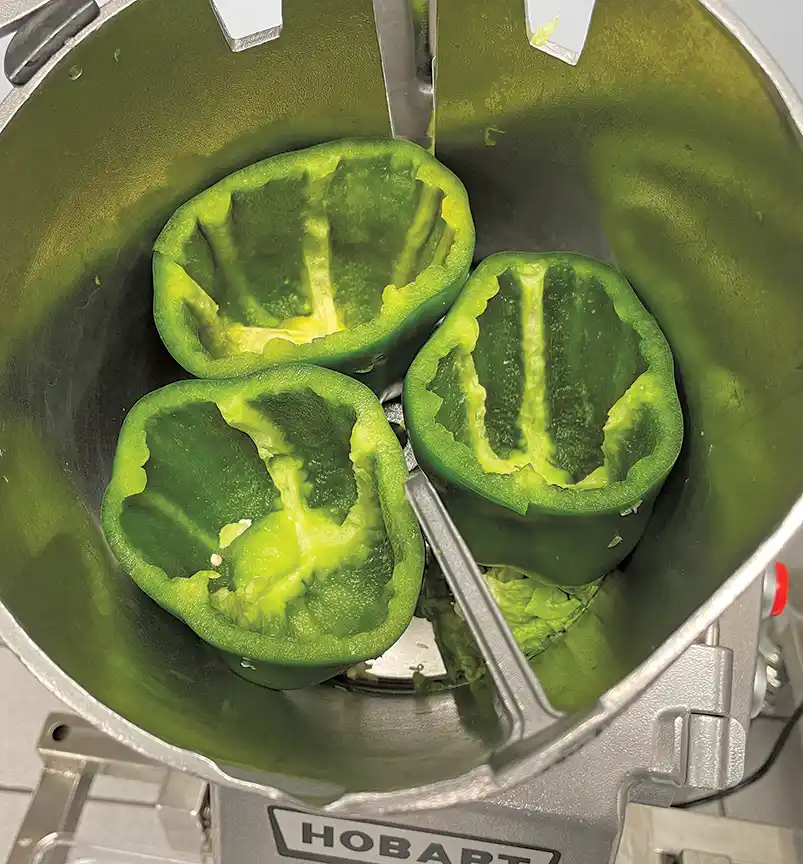
Applying too much pressure
When processing large amounts of produce at a time or bulkier product like cheese, it can be tempting to apply more pressure on the handle.
Most of the time, however, excess pressure can lead to a poor-quality cut or worse, damage to the food processor and the expense of a service call.
Many continuous-feed food processors are gravity-fed. That means gravity and the weight of the handle itself will do most of the work.
Employees may need to apply slight pressure but should be careful not to hang on the handle or press too hard.
Cleaning ineffectively
It is easy to make the mistake of not cleaning effectively, but taking on the task correctly doesn’t have to be difficult. Food processors with removable parts make the job especially easy.
Kitchen staff can remove the hopper and cutting tools and wash them in a three-compartment sink or the dishwasher. They should always refer to the operator manual to see which parts can go into the dishwasher.
Allow removable parts to air dry before reassembling. Always hang up cutting tools on a wall rack after cleaning to avoid damaging the tool.
To clean the base of the food processor, use a sanitizing solution and cloth to wipe away excess debris.
Gaining efficiency
When used properly, a continuous-feed food processor can contribute to efficiency in the kitchen and help restaurants make the most of their available labor.
With less time spent prepping produce, nuts and cheeses for recipes, chefs and their staff can spend more time focused on recipe development and streamlining operations to better serve their customers.


















